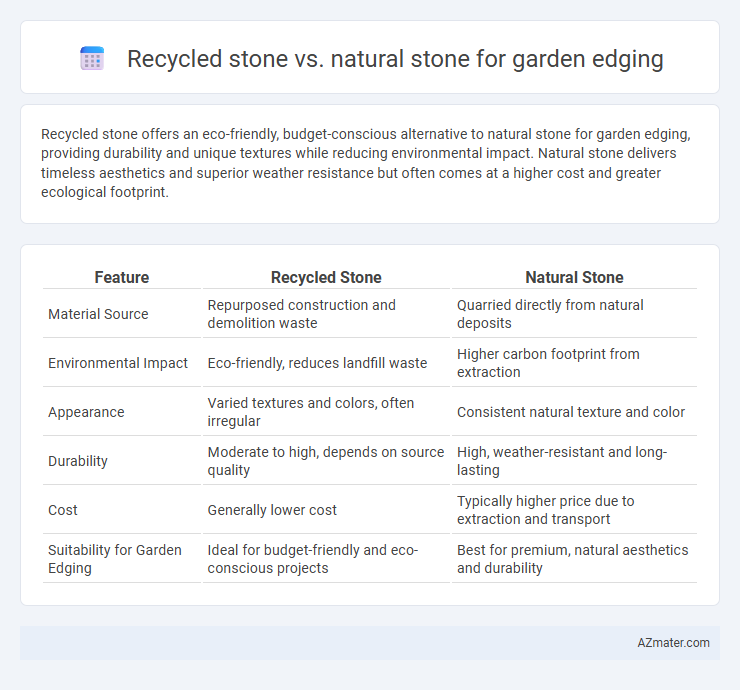Recycled stone offers an eco-friendly, budget-conscious alternative to natural stone for garden edging, providing durability and unique textures while reducing environmental impact. Natural stone delivers timeless aesthetics and superior weather resistance but often comes at a higher cost and greater ecological footprint.
Table of Comparison
| Feature | Recycled Stone | Natural Stone |
|---|---|---|
| Material Source | Repurposed construction and demolition waste | Quarried directly from natural deposits |
| Environmental Impact | Eco-friendly, reduces landfill waste | Higher carbon footprint from extraction |
| Appearance | Varied textures and colors, often irregular | Consistent natural texture and color |
| Durability | Moderate to high, depends on source quality | High, weather-resistant and long-lasting |
| Cost | Generally lower cost | Typically higher price due to extraction and transport |
| Suitability for Garden Edging | Ideal for budget-friendly and eco-conscious projects | Best for premium, natural aesthetics and durability |
Introduction to Stone Garden Edging
Stone garden edging enhances landscape design by defining garden beds and pathways with durability and aesthetic appeal. Natural stone offers unique textures and colors formed through geological processes, providing an organic look and long-lasting strength. Recycled stone, sourced from reclaimed materials, presents an eco-friendly, cost-effective alternative that reduces environmental impact while maintaining functional and visual quality.
What is Recycled Stone?
Recycled stone for garden edging consists of repurposed materials derived from crushed concrete, bricks, and other construction debris, offering an eco-friendly alternative to natural stone. Its durability and versatility make it suitable for defining garden beds, pathways, and borders while reducing environmental impact by minimizing waste. Recycled stone often comes in varied shapes and sizes, providing cost-effective landscaping options without compromising aesthetic appeal.
Defining Natural Stone for Landscaping
Natural stone for landscaping refers to quarried materials like granite, limestone, and slate, prized for their durability, natural textures, and aesthetic appeal in garden edging. Unlike recycled stone, which is reclaimed from construction debris or old patios, natural stone offers consistent quality and color variations unique to geological formations. Its resistance to weathering and natural erosion makes it a long-lasting option for defining garden boundaries with a timeless, organic look.
Environmental Impact: Recycled vs Natural Stone
Recycled stone for garden edging significantly reduces environmental impact by reusing existing materials, minimizing quarrying activities, and lowering carbon emissions associated with extraction and transportation. Natural stone, while durable, involves intensive mining processes that disrupt ecosystems and deplete non-renewable resources. Choosing recycled stone supports sustainable landscaping practices by decreasing waste and conserving natural habitats.
Durability and Longevity Comparison
Recycled stone for garden edging offers a sustainable option with moderate durability, typically lasting 10 to 15 years depending on environmental exposure and maintenance. Natural stone, such as granite or limestone, provides superior durability and longevity, often exceeding 50 years due to its dense composition and resistance to weathering. Selecting natural stone ensures a lasting garden border with minimal replacement, while recycled stone balances eco-friendliness with reasonable lifespan.
Aesthetic Differences in Garden Design
Recycled stone offers a unique, rustic aesthetic with varied textures and colors that enhance garden edging through eco-friendly charm, contrasting the uniform, classic appearance of natural stone known for its durability and timeless elegance. Garden designs utilizing natural stone often emphasize clean lines and sophisticated cohesion, while recycled stone provides a more organic, eclectic feel that complements sustainable landscaping themes. The choice between recycled and natural stone significantly influences the garden's visual impact, balancing environmental consciousness with design preferences.
Cost Analysis: Recycled Stone vs Natural Stone
Recycled stone for garden edging offers a significant cost advantage, often priced 30-50% lower than natural stone due to its sourcing from reclaimed materials and reduced processing requirements. Natural stone typically involves higher extraction, transportation, and labor expenses, driving up overall installation costs. Budget-conscious landscaping projects benefit from recycled stone's affordability without sacrificing durability and aesthetic appeal.
Installation and Maintenance Requirements
Recycled stone for garden edging offers easier installation due to its lightweight nature and uniform size, reducing labor time and effort compared to natural stone, which often requires more precise placement and handling due to irregular shapes and heavier weight. Maintenance of recycled stone is generally low, as it resists weathering and breakage, whereas natural stone may require periodic sealing and can be prone to chipping or erosion over time. Choosing recycled stone can enhance long-term durability and simplify upkeep, making it a practical option for sustainable landscaping projects.
Availability and Sourcing Issues
Recycled stone offers greater availability since it is sourced from reclaimed materials, reducing dependency on quarrying and conserving natural resources. Natural stone availability varies by region and is limited by quarry depletion, environmental regulations, and transportation costs. Sourcing recycled stone supports sustainable landscaping practices by minimizing waste and lowering the carbon footprint associated with extraction and processing.
Choosing the Best Stone for Your Garden Edging
When choosing the best stone for garden edging, recycled stone offers an eco-friendly option with unique textures and colors that enhance garden aesthetics while reducing environmental impact. Natural stone provides durability and classic beauty, with a variety of types like granite, limestone, and slate that withstand weather conditions and add long-lasting structure. Consider factors such as cost, sustainability, and design preferences to balance functionality and visual appeal in your garden landscape.

Infographic: Recycled stone vs Natural stone for Garden edging
 azmater.com
azmater.com